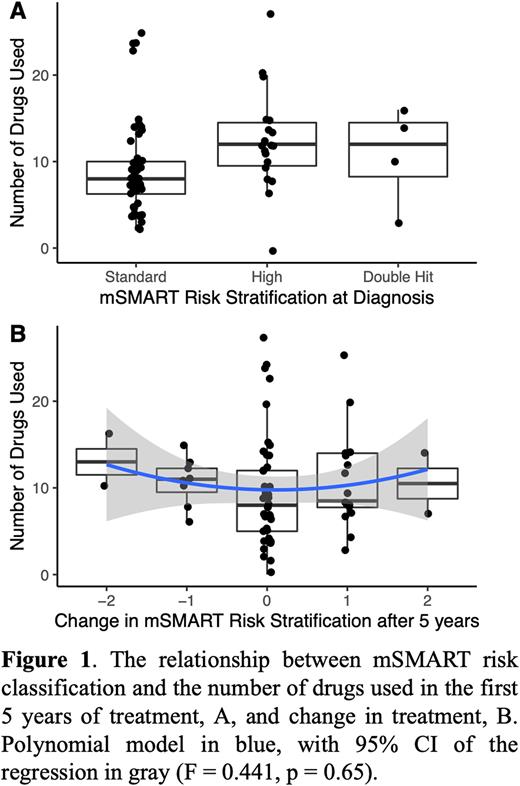Abstract
Background: Multiple myeloma (MM) is a subclonal disease characterized by the growth and evolution of malignant plasma cells affected by multiple factors such as therapeutic pressure. This study aims to explore, using real-world-data, if the therapeutic pressure intensity (number of anticancer drugs) from MM diagnosis to 5-years affects the genetic risk level of myeloma patients over time.
Methods: Utilizing HealthTree® Cure Hub, a robust data set of myeloma patients with fully validated medical records, the relationship between the number of drugs and risk stratification over the first 5 years of MM treatment was evaluated. Patients were included with diagnosis dates between 2010 and 2017, with a fluorescence in situ hybridization (FISH) test for mSMART risk stratification within 6 months of diagnosis. The number of drugs were counted during the first 5 years of diagnosis with a study end date of January 1st, 2022. The relationships between 5-year drug utilization rate and mSMART risk stratification was investigated with a repeated measures mixed linear model with random intercepts, polynomial regression and Pearson's correlation coefficient. Alpha was set at 0.05 and data are mean±SD.
Results: The analysis was performed on 73 MM patients with validated medical data. The mean age was 64±9 years, 37 (51%) female and 12 (16%) relapsed during the observed 5 years. On average 10 ± 6 (0-27) different drugs were taken during the first 5 years of living with MM. At diagnosis 50 (68%) were standard risk, 19 (26%) were high risk, and 4 (5%) were double hit (Figure 1A). After 5.0±0.5 years, 47 (64%) were standard risk, 18 (25%) were high risk, 7 (10%) were double hit, and 1 (1%) was triple risk, resulting in 2 (3%) decreasing risk by 2 levels, 8 (11%) decreased risk by 1, 45 (62%) had no change in risk, 16 (22%) increased risk by 1 and 2 (3%) increased risk by 2 (Figure 1B). There was no relationship between risk level at diagnosis, 5 years after diagnosis or change in risk score after 5 years with the number of drugs used to treat MM (r = 0.20, 0. 15, -0.01, respectively) (Figure 1A and B).
Conclusion: Interestingly, the risk classification at diagnosis was not related to the number of drugs utilized during the initial 5 years of treatment. Importantly, the number of drugs used had no relationship with the patients' evolution of malignant plasma cells as assessed by FISH and mSMART risk stratification after 5 years or the change in risk classification. Although MM patients may express concerns for increased mSMART risk stratification from therapeutic pressures, early in their MM cancer journey, this real-world-analysis documents this should not be a factor when strategizing an effective treatment regimen to reach long-term disease control.
Disclosures
Ahlstrom:Pfizer, BMS, Janssen, Takeda Oncology, Sanofi: Consultancy, Honoraria, Membership on an entity's Board of Directors or advisory committees.
Author notes
Asterisk with author names denotes non-ASH members.


